Yamaha’s Sport Heritage models are exquisitely tasteful machines. Technologically, they feature the latest advancements in the market, yet their philosophy harks back to another era. This is taken to the extreme with the XSR900 GP, a motorcycle that evokes the competition spirit of the past. Can you squint and see the YZR 500 of Wayne Rainey here? We can too.
Since 2015, various Yamaha models have passed through this sub-segment of Sport Heritage motorcycles, notably the last version of the beautiful XJR 1300, the more urban SR400, and even the cruiser/scrambler SCR 950. In recent years, the XSR models have stood out, and currently, this is the only badge present among the Sport Heritage models, with one curious fact: the XSR900 GP is the only sportbike among them. A sportbike created based on the XSR900, an excellent naked bike equipped with the proven CP3 three-cylinder engine, now transformed to recall Yamaha’s rich racing past.
Over the years, numerous famous customization projects have also emerged based on various models – often using the XSR700 as a base – within a Sport Heritage segment that only accounts for 10% of Yamaha’s sales (compared to the Hyper Naked segment’s 42%), but which still holds significant importance within the brand, generating much passion. As new model projects take much longer to come to fruition than people think, the XSR900 GP project was questioned multiple times –particularly due to the Covid-19 pandemic – which complicated matters and required remote development, a joint effort between Yamaha Europe and Japan. Fortunately, all hurdles were overcome, and we arrived at this beautiful final result, which may look good in photos and videos, but believe me, is much more stunning in person.
SPORTBIKE
After selling over 80,000 Sport Heritage units in recent years across various styles, Yamaha decided to cater to what sport and racing motorcycles were. The brand did not base it on a single sport or racing model but on a motorcycling era of the ’80s and ’90s when the brand achieved many successes in GPs, featuring names like Kenny Roberts, Giacomo Agostini, Eddie Lawson, and Wayne Rainey. Thus Yamaha took its XSR900 and developed a bike reminiscent of those nostalgic machines, in a compact yet long wheelbase package, with 55 mm more than the MT-09. Several aesthetic details are inspired by different motorcycles (which the fans will immediately identify), and the entire riding position is spectacularly retro (fairing top and respective bracket, various fastenings, and fork tops), except for the TFT instrumentation and modern controls.
Further back, the rider’s seat is now more comfortable than on the XSR, while the rear of the naked model has been fitted with a retro number plate cover, hiding the passenger seat. And of course, to maintain the GP aesthetic, minimalist headlights were used, with a dual compact projector at the front that we did not have the opportunity to test at night. Notably, the two paint schemes feature extreme care in application, with five carefully applied layers. As for being semi-faired (the full fairing you may have seen in various photos and videos is an extra), it’s because it is essentially a road bike, which with this look even resembles the Yamaha TRX850. Do remember it? The lower fairing is part of the Racer accessory package, along with the dark windshield, smaller license plate holder, and complete Akrapovic exhaust.
DIFFERENCES
The frame and swingarm have undergone only slight reinforcements, while the engine, this three-cylinder, is now Euro5+ compared to the Euro5 of the previous XSR900 launched in 2022, though the numbers are similar. It delivers 119 hp of power and a maximum torque of 93 Nm, with revised intake and smoother gearbox engagement. Compared to the naked bike as we already knew, the ergonomics have obviously changed in terms of seat position, clip-ons, and footpegs, that now are more similar to the R7. Some dimensions have also slightly changed compared to the XSR900 (more trail for example), in a 200 kg package that has been improved in terms of handling: braking with a new Brembo master cylinder and KYB suspensions with many more adjustments. These are now fully adjustable, with numerous settings and even high and low-speed compression adjustments front and rear.
The lightweight wheels are fitted with very grippy Bridgestone tires (Battlax S23), and in the realm of electronic aids, there is a 6-axis IMU derived from the R1 that controls 7 electronic systems. The fixed riding modes are 3 (Sport, Street, and Rain), plus 2 customizable ones, and on the 5-inch TFT display, we can choose several backgrounds. We started the day with Garmin navigation (paired with the brand’s app) but later chose the beautiful retro-lined digital tachometer. The quickshifter system is third generation, and there is even a cruise control for when we’re getting tired and just want to reach our destination!
ROADS, LITTLE ROADS, AND TRACK!
This international presentation was based around Ericeira, and throughout the day we were treated to excellent weather conditions (even too hot at times) and roads for all tastes. We rode a GP without accessories but noticed that the Akrapovic exhaust on our guide’s bike (the always helpful Jorge Santos from Yamaha Portugal) didn’t sound very different. Still, the original exhaust already pleases with its sound and even offers some backfires, but even better is the quality of the entire setup and the good aesthetic taste, even when riding.
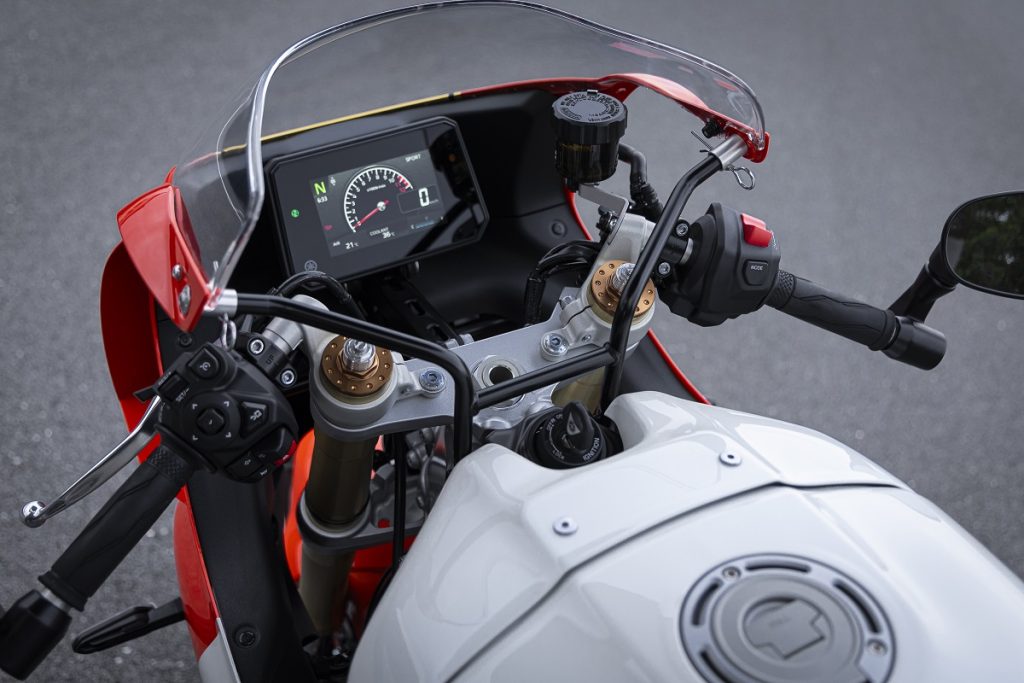

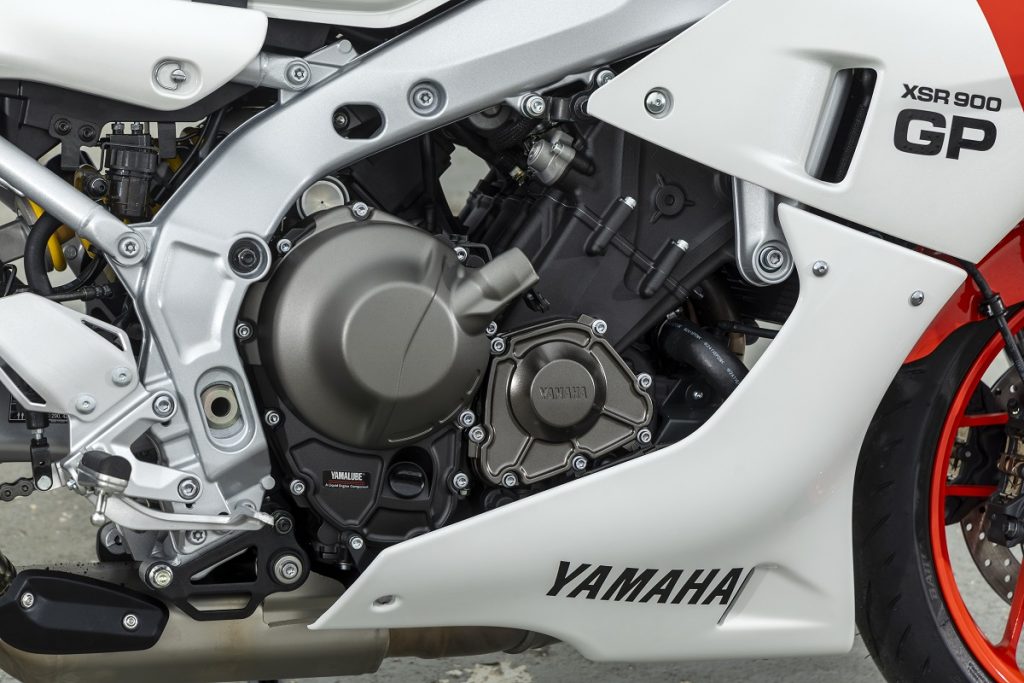
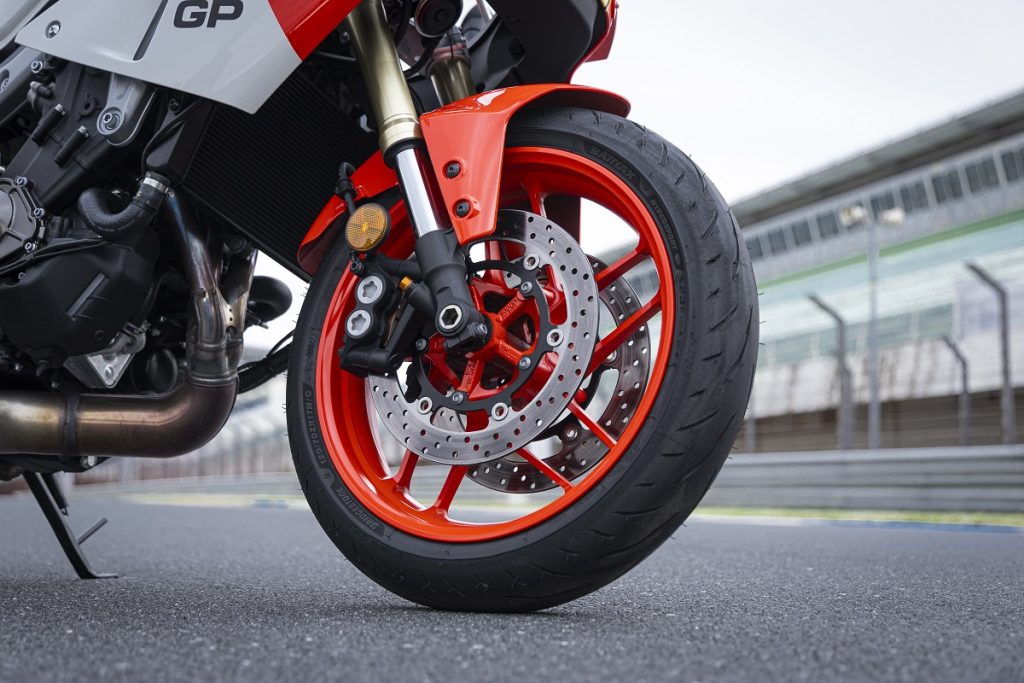
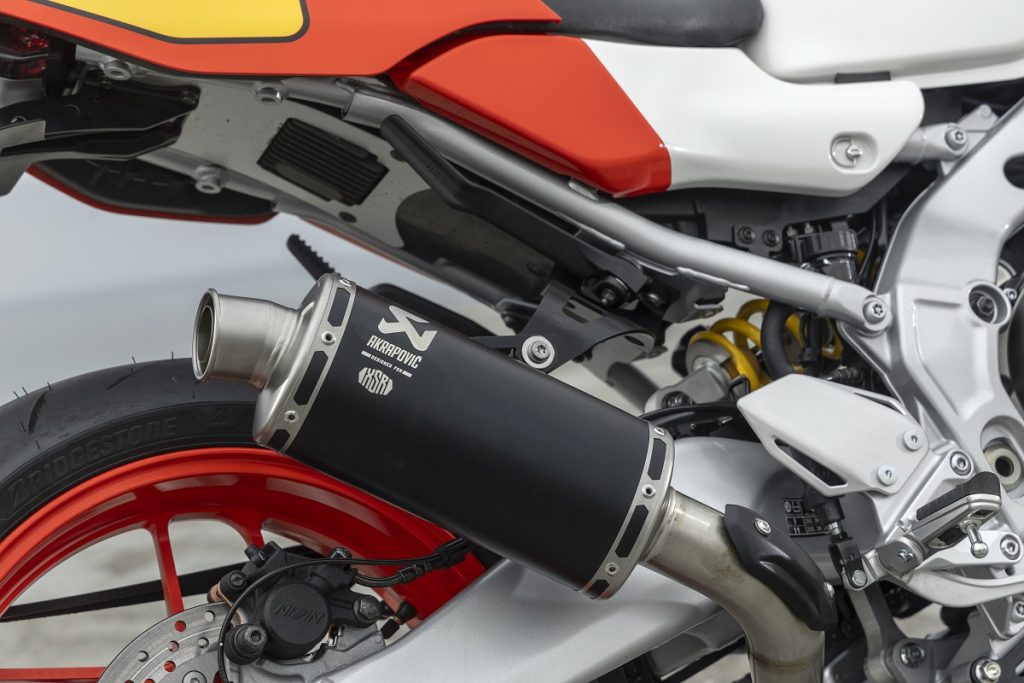
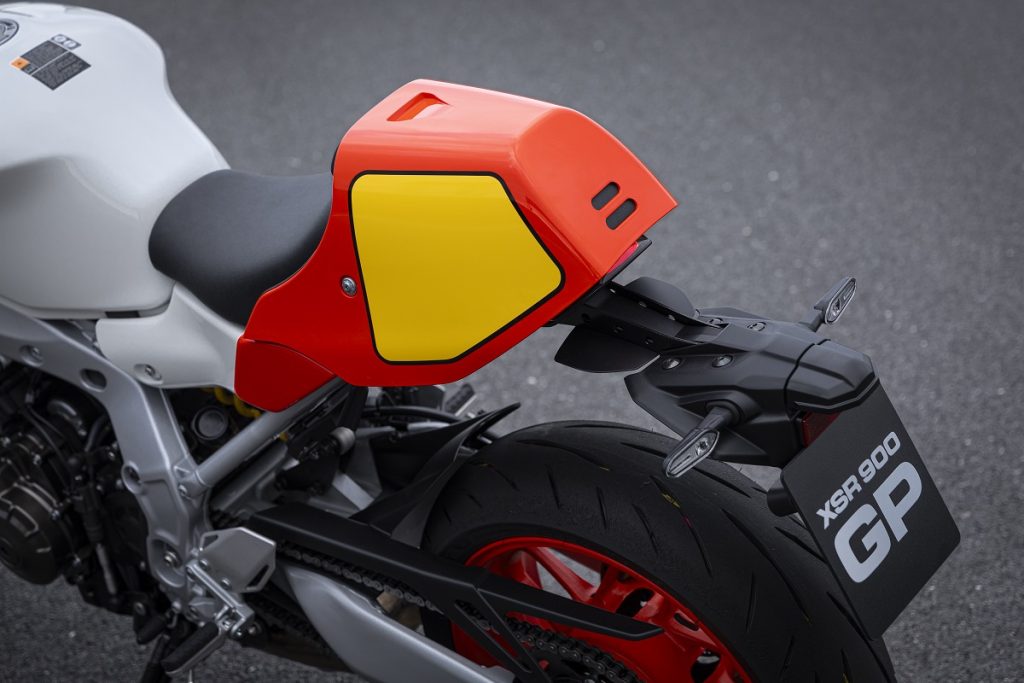
In front of us, we have a beautiful tank and a fairing that really seems from another era, although in motion everything is much better than in the past… the engine responds promptly and flawlessly, and the handling quality is high, which we noticed right from the start, although the original suspension setup is somewhat stiff for rougher roads, and we found some around Sintra. The engine is lively and fun – as expected with a good bidirectional quickshifter – and the braking is also of high quality, though it requires more lever force than we expected for quick stops. As for the riding position, being very similar to any sportbike, it is therefore more tiring on rough surfaces or at low speeds.
SHEER FUN
Then, it’s practically perfect when the best conditions for this bike are met, and we were lucky enough twice: for some photos and videos at the Circuito do Estoril and later on our well-known lagoon road in the Sintra mountains. We didn’t do complete laps on the track, hence not wearing a leather suit (though we had all necessary protections), but it was clear that the XSR900 GP’s limits were still far off. A strong engine and excellent handling set the tone, along with quite acceptable ground clearance, for excellent moments, especially on an innovative day when we took some corner sequences in the reverse direction to the traditional one, which is quite challenging! Then, in the Sintra mountains that we know so well, we continued with enormous confidence, and I can say this was one of the bikes I felt most confident on this road to ride fast, thanks to the tremendous stability of the setup, very capable handling, strong engine, and excellent tires for sporty road use.
After these good moments, the return to the hotel was a bit challenging, as we went back to rough roads, heavy traffic, and already tired wrists. So, this XSR900 GP is everything we imagined: a passion bike that makes you want to keep it pristine in the garage (or living room), but also an immense joy to ride on the road or track. However, certainly few will use it daily. It is perfectly capable for such use, but being somewhat radical in terms of riding position, there are better options in the Yamaha range for that. Altogether, we covered about 200 kilometers, with an average fuel consumption of 5.5 l/100 km, alternating between Sport and Street modes depending on the moment.
And so, at the end of this presentation, that familiar feeling emerged that sometimes appears in this profession: the desire to add another bike to our (imaginary) collection in our garage!
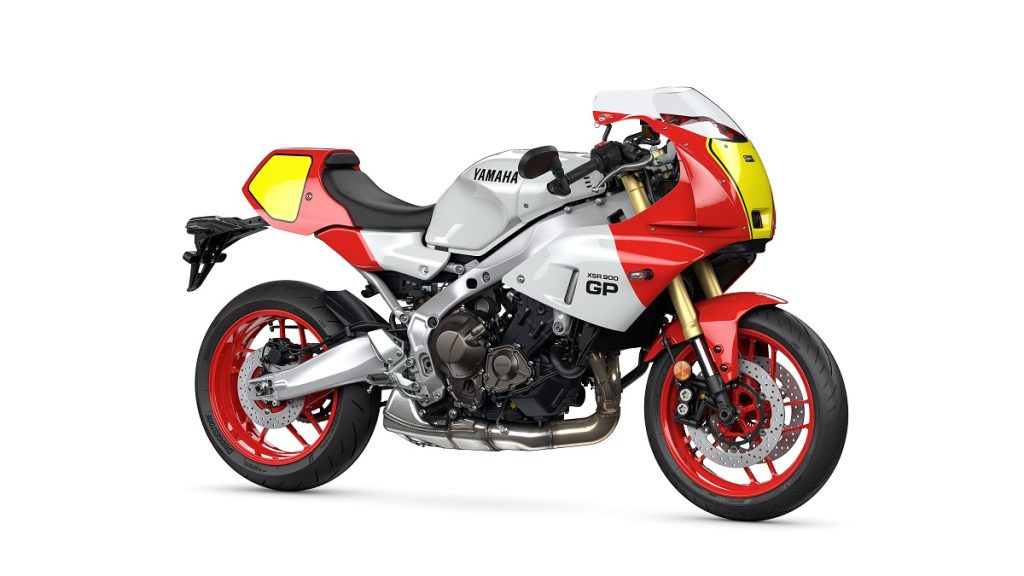
YAMAHA XSR900 GP
- ENGINE 3-cylinder inline, DOHC, liquid-cooled
- DISPLACEMENT 890 cc
- POWER 119 cv (87,5 kw) @10.000 rpm
- TORQUE 93 Nm @7.000 rpm
- GEARBOX 6-speed
- FRAME Diamond type in aluminium
- FUEL TANK 14 liters
- FRONT SUSPENSION adjustable inverted suspension, 130 mm travel
- REAR SUSPENSION adjustable single shocks, 131 mm travel
- FRONT BRAKE dual disc brake de 298 mm, 4-pistons radial clipers
- REAR BRAKE single disc brake, 245 mm, 1-piston cliper
- FRONT TYRE 120/70ZR17
- REAR TYRE 180/55ZR17
- WHEEL BASE 1.500 mm
- SEAT HEIGHT 835 mm
- WEIGHT 200 kg
- PRICE from 12.506 £







